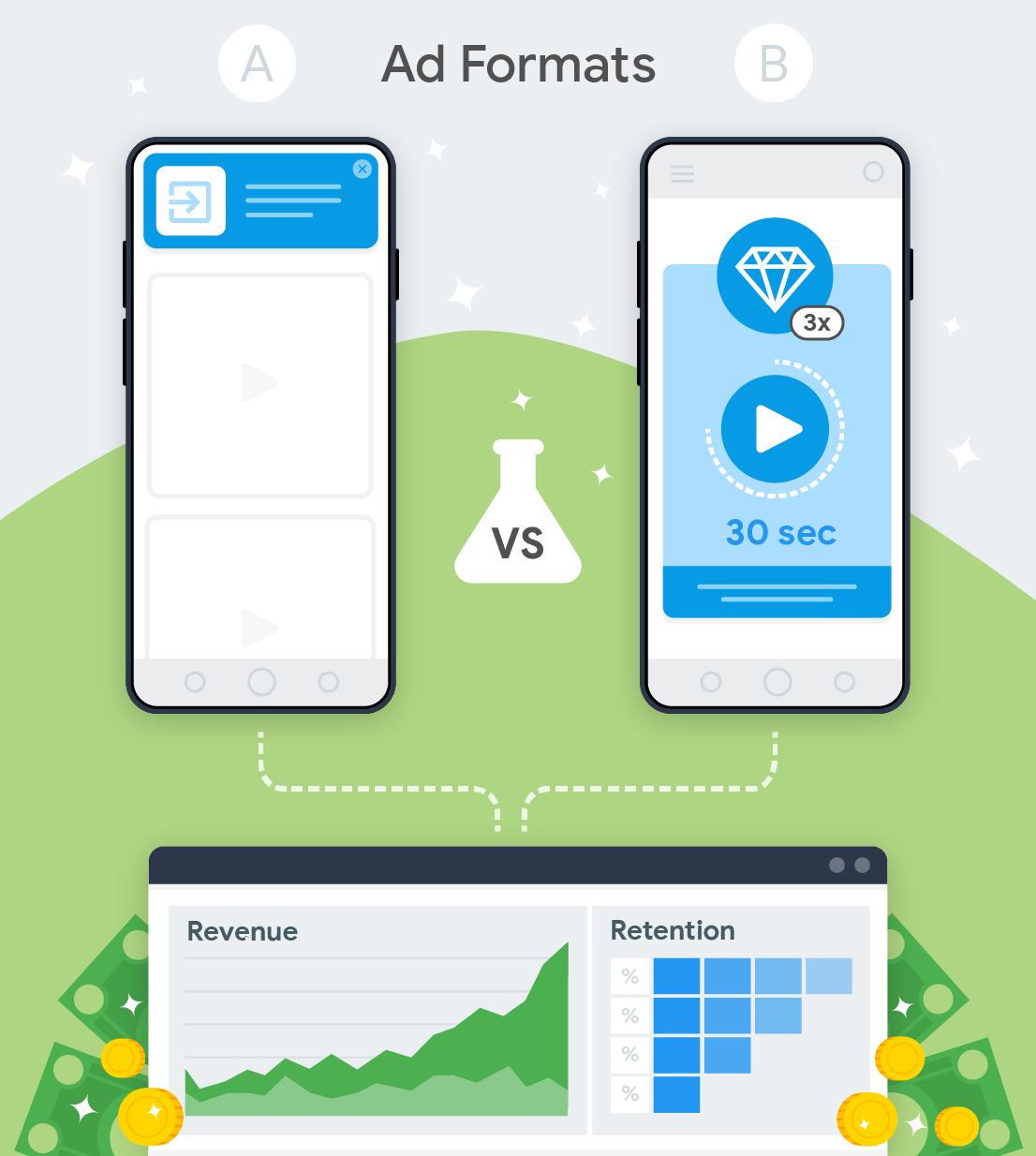
Solution tutorial
The adoption of different ad formats can be complicated, but Firebase offers tools that help you test and then make data-driven decisions about adopting new ad formats.
Using Firebase, you can A/B test the performance of a new ad format with a small subset of users.
You can observe the test results and review recommendations from Firebase about whether the new ad format is performing better than the existing ad format.
Once you're confident that the changes will likely have a positive impact, you can roll out the changes to more of your users with a click of a button.
What you'll learn
In this multistep tutorial, you'll learn how to use Firebase to test a new Google AdMob ad format for your app. It uses a rewarded interstitial ad as the example test case, but you can extrapolate and use these same steps to test out other ad formats.
This tutorial assumes that you already use AdMob in your app and that you'd like to test whether adding another ad unit (with a new ad format) will have an impact on your app's revenue or other metrics. However, if you don't already use AdMob in your app, that's ok! The steps in this tutorial can also help you understand if simply adding an ad unit to your app has an impact on your app's metrics.
Learn more about the business case and value for this solution in our Test adoption of new AdMob ad formats solution overview.
Products and features used in this tutorial
|
Google AdMob Google AdMob enables you to create ad unit variants that will be served within your app. When you link AdMob with Firebase, AdMob sends ad revenue information to Firebase to improve ad strategy optimization. Google Analytics Google Analytics gives you insight into user engagement, retention, and monetization metrics like total revenue, AdMob revenue, purchase revenue, and much more. It also allows you to create user audiences and segments. |
Firebase Remote Config Firebase Remote Config enables you to dynamically change and customize the behavior and appearance of your app for desired user segments — all without publishing a new version of your app. In this tutorial, you'll use Remote Config parameters to control whether a new ad unit is shown to your users. Firebase A/B Testing Firebase A/B Testing provides the interface and infrastructure to run product and marketing experiments in your app. It takes care of distributing experiment variants to users, and then performs statistical analysis to determine if an experiment variant is outperforming the control group based on your selected key metric, such as revenue or user retention. |

Tutorial overview
Go directly to the step-by-step tutorial
Use AdMob to create a new ad unit variant for testing
Create a new rewarded interstitial ad unit in AdMob.
Implement the ad unit placement within your app's code.
Set up an A/B test in the Firebase console
Define testing basics, targeting, and the goals that the test will run against.
Define test variants and set up the Remote Config parameter that will control whether to show the new ad unit to users in the test.
Handle Remote Config parameter values in your app's code
Use the Remote Config parameter in your app.
Implement the logic for displaying the ad unit based on the parameter's value.
Start the A/B test and review the test results in the Firebase console
After starting the test and allowing it to run for a few days or weeks, check the Firebase console for whether the A/B test has a winning variant based on the primary goal of the A/B test.
Review the impact on secondary metrics for each variant to ensure the variants didn't cause unintended negative impacts to those metrics.
Decide whether to roll out the new ad format
If A/B Testing determines that the variant showing the new ad format is the winner, you can start showing the ad format to all users targeted in the experiment, all users of your app, or to a subset of your users.
If a clear winner isn't yet determined, you can either continue running the experiment to gather more data, or end the experiment if it's already been running for a long period with inconclusive results.
What you'll need
Your own app (iOS, Android, or Unity project)
Your app registered as a Firebase App that's linked to an AdMob App (learn more)
Access to your app's associated AdMob account, with permissions to create new ad units
Access to your app's associated Firebase project, with permissions to create and manage Remote Config and A/B Testing as well as to view Google Analytics
Your preferred IDE
Glossary
AdMob revenue: AdMob network and open bidding revenue
IAP revenue: In app purchases revenue
Total revenue: Total revenue
Retention: Retention as a key metric in A/B tests is tracked as 1 day, 2-3 days, 4-7 days, 8-14 days, or 15+ days user retention
Remote Config parameter: The configurable parameter used to control whether we show the new ad format or not. In this guide, it will be a boolean value.
Baseline configuration: The as-is configuration in any particular A/B test — also known as the control. The control usually uses the default value for the Remote Config parameter, but it can be configured to use a new control value if needed.
Variant configurations: The variant configurations are the alternative configurations with different Remote Config parameter values that we would like to test against the baseline configuration.
Step 1: Use AdMob to create a new ad unit variant
